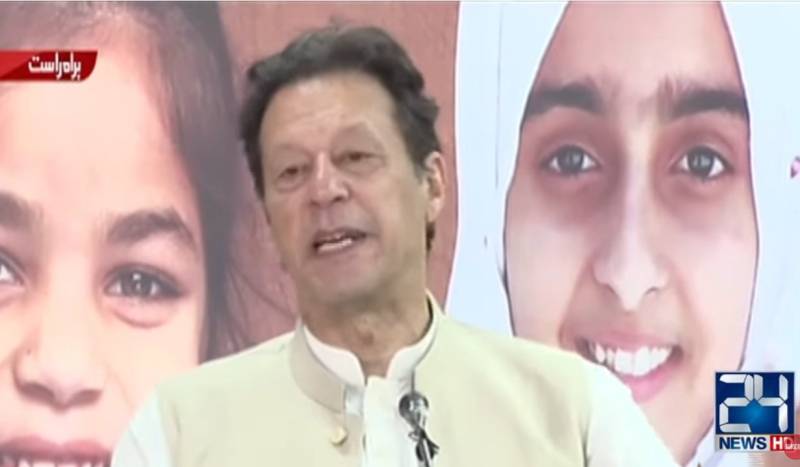Ehsaas stipend carries more amount for girls than boys
PM Imran says 20 million out-of-school children to be included in educational mainstream

Stay tuned with 24 News HD Android App

Prime Minister Imran Khan on Wednesday said the government has laid its focus on providing education to all children across the country and giving incentives to prevent dropouts from schools.
Addressing at the launch of Ehsaas Education Stipends programme in Islamabad, the prime minister said as over 20 million children in the country were out of schools, efforts were underway to ensure their inclusion in the educational mainstream.
The Ehsaas Education Stipends programme aims at providing financial assistance to the deserving households for the education of their children at primary, secondary and higher secondary levels.
Rolled out nationwide in 160 districts, the programme has been structured to give higher amount of stipend to girls as compared to boys.
The prime minister said ensuring education for all was a priority of the government, adding that stipends as incentives would be a step to encourage parents send their children, particularly girls to schools.
He said an educated woman could contribute more positively towards the society and lauded the policy of Ehsaas Stipends programme to give higher amount to girls.
Terming educated human resource a great asset for a nation, he said it was important to provide educational opportunities to both boys and girls.
He dismissed the impression in western world that Pakistanis did not want to educate their girls.
He recalled that during his visits to different parts of the country, he found no such parents opposing the right of education for their daughters. However, he said the factors including distant schools or unavailability of female teachers could be a reason.
Imran Khan said it was mainly the responsibility of the government to provide facilities of education to all.
He appreciated that by use of information technology, the stipends would be disbursed transparently after proper checking of fake entries and ghost schools.
The Prime Minister also announced a one-time Ehsaas graduation bonus of Rs. 3,000 to encourage girls to complete primary education. This award is being given to girl students completing Grade 5 from Ehsaas eligible families. The graduation bonus has been designed to encourage girls’ education till secondary level.
PM’ Special Assistant to Social Welfare Dr Sania Nishtar said under the Ehsaas Education Stipends, the primary school boys would get quarterly stipends of Rs1,500 and girls Rs2,000; secondary school boys would get Rs2,500 and girls Rs3,000; and at higher secondary level, boys will get Rs3,500 and girls Rs4,000 a quarter.
She said all education stipends would be paid biometrically to mothers on attainment of 70 percent attendance of their children.
She said as part of ‘Post-COVID-Ehsaas Strategy’, Ehsaas Education Stipends would empower the deserving families to overcome financial barriers in accessing higher education.
Poverty is one of the most persistent barriers to acquiring education. Presently, there are 18.7 million children in the age group 6 to 16 who remain out of school in the country and the fall out of COVID-19 has also accentuated it.
The Education Conditional Cash Transfers are an important pillar of Ehsaas and are included in the Ehsaas framework as Policy #73 ‘Education Conditional Cash Transfers’.
The Education Conditional Cash Transfers (CCT) serve the dual purpose of socially assisting vulnerable households and at the same time reduce the number of out of school children, which is an important outcome for Pakistan given that there are 18.7 million out-of-school children in the country.
Pakistan has been running an Education Conditional Cash Transfer for primary school going children called Waseela-e-Taleem since 2012 in selected districts. The programme encountered a number of challenges including high administrative cost charged by NGOs that were administering the programme, high error and fraud due to the programme being paper-based, weak compliance monitoring, limited human resource to enroll students into the programme and low stipend amount being given to children.
Also, it was limited to 5th grade and not including secondary education, whereas the latter could be of high impact.
Studies reveal that school drop-out rate increases with age especially for girls in classes 5 to 8, owing to distance from the school and other associated costs. The previously run education CCT was limited in geographic scope and lacked appropriate federal-provincial partnerships. Also, payments to beneficiaries were being made through the old BISP payment system which was plagued by many challenges.
On the other hand, Ehsaas Education Stipends challenges is a cost-effective institutional infrastructure developed to be implement program nationwide with reliance on NGOs eliminated.
Because of this, the operational cost has been reduced from 8 to 3 percent. The end-to-end digitization of a number of processes has eliminated the space for abuse in terms of ineligible children being enrolled. The compliance monitors have been hired and a Project Monitoring Unit has been established.
Also, through an MoU with the National Commission on Human Development, additional 1000 staff members have been engaged to enroll students. The stipend amount has been doubled for primary school going children and has been further increased for girls.
